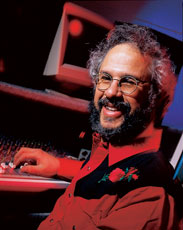|
|
Studio Integration |
May 2001 |
|
One of the biggest reasons for the personal studio's explosive growth during the 15 years EM has been around is the establishment of the MIDI specification. Before, some musicians bought a few expensive synthesizers and perhaps a step sequencer. With luck you could get your hands on a MIDI guitar, but many early units were not ready for prime time.
Different companies' products rarely worked well together, so integrating gear was a crapshoot. Synthesists had fun, but we were the few, the proud, the masochists. Manufacturers fought for sales, and they rarely agreed on anything ’Äî from CV values and nomenclature to the program-numbering system when programmable synths arrived.
MIDI changed that, though not all at once. It opened the door to the modern sequencing era, sound modules, programmable effects, fader boxes, and instrument controllers. Some additions to the MIDI spec ’Äî such as General MIDI, Standard MIDI Files, and MIDI Show Control ’Äî broadened MIDI control's influence considerably.
Given that MIDI opens so many doors, it should be no surprise that today's electronic musicians buy a variety of mainstream MIDI controllers ’Äî not just keyboards but MIDI guitars, wind controllers, and an assortment of percussion instruments. Exotic MIDI controllers are available too; we did a major article about exotic controllers (MIDI and non-MIDI) in our August 2000 cover story, ’ÄúThe Outer Limits.’Äù
EM boasts MIDI wind-controller expert Scott Wilkinson, string-controller wizard Marty Cutler, and MIDI percussionist Gino Robair. Cutler and Robair wrote the aforementioned story about exotic controllers, and they were champing at the bit to do a similar story about their favorite mainstream controllers. So I let all three editors out of their cages and sent them out to get the story of today's MIDI string, wind, and percussion controllers. I think you'll agree that their article (’ÄúIn Control,’Äù p. 64) is a must-read for musicians interested in those types of controllers.
Such established formal standards as AES/EBU, S/PDIF, word clock, and SMPTE time code and de facto standards such as ADAT Optical and Tascam TDIF have helped fuel the digital-audio revolution. DirectX, the VST plug-in format, the WAV and MP3 audio-file formats, and ASIO audio-card drivers have been a huge help to computer-based musicians. Digidesign's TDM is the centerpiece of a thriving development community, although it is not an open standard.
All this and the concurrent growth of codevelopment alliances between manufacturers makes our lives as recording musicians a whole lot better. It also helps the music industry grow in more ways than we can count. Today it is a given that manufacturers should think about ways to make their products ’Äúplay well with others.’Äù Larry the O alludes to this in his ’ÄúFinal Mix’Äù column (’ÄúPlaying Card Games,’Äù p. 210).
But achieving tight studio integration is as much the studio owners' responsibility as it is the manufacturers'. We end users need to think in terms of purchasing gear with integration in mind. In future issues, we'll address the concept of creating a studio so well integrated that it can be treated as a single device. |
